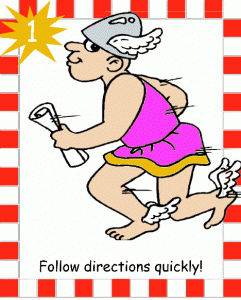Each year I establish the “rules” of my lesson using Whole Brain Teaching developed in 1999 in the small Southern California town of Yucaipa by three instructors, Chris Biffle (college), Jay Vanderfin (kindergarten) and Chris Rekstad (4th grade). They spent a year designing a radical new teaching system based on three principles: the system should be brain based, fun and free.
I agree that it is indeed all three.
In all my classes I begin by teaching the class attention getter ” Class-Yes”. This develops a signal system in which the students answer “yes” to your saying “class”. The fun part is that you say this “class” using a variety of different voices or tones that they need to match. I use this when I either see some students drifting from listening or when I want to signal something new.
I then do the class rules and there are 5 of them. I talk to the students about that everyone learns differently. Some people learn by listening so we say the rules out loud. Some people learn by seeing so I have pictures for the rules. Some people learn by doing so we ‘act’ out the rules as we say them. I also tell them that we are going to do each rule 3 times to assist them in remembering them.
Rule One:Follow directions quickly! (the gesture: make your hand shoot forward like a fish I add a little forward movement and point one finger in the air)
Rule Two:Raise your hand for permission to speak (the gesture: raise your hand and have 2 fingers out, then pull it down next to your head and make a talking motion. )
Rule Three:Raise your hand for permission to leave your seat. (the gesture: raise your hand and have 3 fingers out, and then make a little walking figure with your index and middle finger.)
Rule Four:Make smart choices! (the gesture put four fingers out and tap them on your forehead as you say the rule)
Rule Five:Keep your dear teacher happy! I always tell them that this is my favorite rule of all time and play it up really big. This one I say needs two hands to do the gesture (the gesture: put hand on either side of face with five fingers splayed out and tilt head back and forth as you say the rule).
The class motivator is then discussed. This is a scoreboard divided by a happy face (One second party) and a sad face ( groan). I tell the class that if they get more smiley faces than sad faces there is a reward for the younger children in might be one extra minute of recess while the older children might be able to do a one word hang man. This allows me to encourage the students ( I always tell them why I am putting a mark in) as well as get the class back to following the rules. So a class might get a positive point for working quietly whereas they might get a groan because someone called out instead of raising their hands.
The last thing that I teach them is Teach-OK.
Teach-Ok is a technique that allows you to simultaneously engage the students in all four learning modes — seeing, saying, hearing and doing.
Twenty years of education research tells us that the most effective learning takes place when a student engages the brain’s primary cortices- visual, auditory, language production and motor- at the same time. Further, as students enjoy the experience, their limbic systems become involved. This is the portion of the brain that controls emotional engagement. As you involve all four learning modes at once, and attach a positive emotional experience, students form deep and lasting anchors for the information they are acquiring.
Teach-OK works like this:
The class into teams of two. One student is a One, the other member of the team is a Two.
I present a small amount of information, complete with gestures. When I finish, I look at the class and clap two times, say “Teach!” Your students clap twice and respond “OK!”
The students are taught to copy my gestures (kinesthetic) and mimic the emotion in my tone of voice (limbic). As your students teach each other, I move around the room listening to what they are saying. This is an excellent opportunity for me to monitor student comprehension. Then, I call them back to attention with the Class-Yes! If I am not convinced they have understood the lesson, I repeat it.


